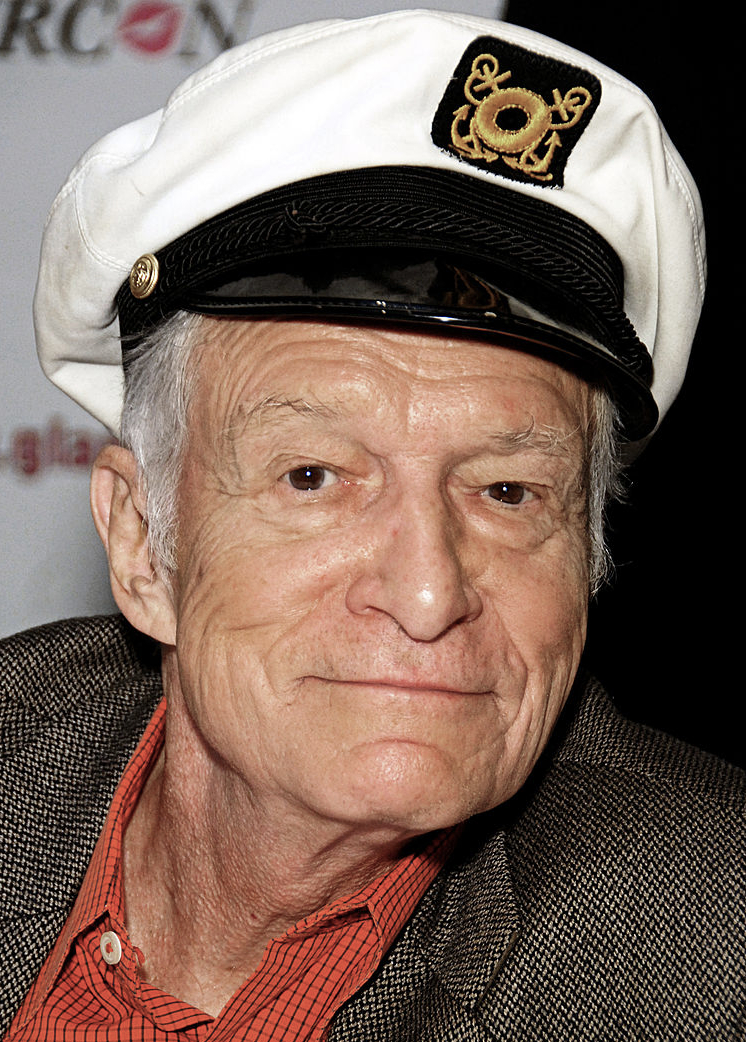On this date in 1926, Playboy mogul Hugh Marston Hefner was born in Chicago, the firstborn of Grace and Glenn Hefner’s two sons. His parents were strict Methodists. He went to school in the city and started a school newspaper at Steinmetz High School. He served in the U.S. Army during World War II. After discharge in 1946, he studied at the Chicago Art Institute for two years and then at the University of Illinois at Urbana-Champaign, completing a degree in psychology in 1950.
After college he began working as a promotional copywriter at Esquire in Chicago, which was then the premier men’s magazine. After three years he left in frustration, determined to start his own publication. With $8,000 from 45 investors, Hefner started Playboy magazine. The first issue was published in December 1953. It was an instant success, selling 50,000 copies. By 1959 Playboy was selling almost a million copies a month and Hefner was expanding his success. Playboy Enterprises established private key clubs, staffed with the iconic “bunnies” as hostesses, high-end resorts and modeling agencies. There were books and films and two television series. By 1970 the publication was selling 7 million copies a month.
After suffering a minor stroke in 1985, Hefner largely stepped back from Playboy Enterprises, leaving his daughter, Christie Hefner, at the helm. He instead focused on philanthropic efforts, making a few notable TV and film appearances to continue promoting the Playboy brand. He championed the issues of free speech and freedom of the press. He established the Playboy Foundation in 1965 to provide grants to nonprofits fighting censorship or researching human sexuality. The foundation also sponsors the Freedom of Expression Award, which is given at Sundance Film Festival every year.
While Playboy became a byword for objectification of women, with Gloria Steinem writing a famed piece, “A Bunny’s Tale,” for Show magazine on May 1, 1963, exposing what it was like to be a “Bunny,” Hefner placated some feminist critics by defending women’s reproductive rights. The A&E network’s 12-part miniseries titled “Secrets of Playboy” started airing in early 2022. Directed by Alexandra Dean, it reexamined Hefner and Playboy Enterprises through the lens of 2022 and in the wake of #MeToo. Dozens of women appear in the documentary to allege decades of sexual predation, including rape, and extensive use of illegal drugs and secret recordings inside the Playboy Mansion in the Holmby Hills neighborhood of Los Angeles.
In response, an open letter signed by about 500 people defended Hefner, calling the allegations unfounded: “From all we know of Hef, he was a person of upstanding character, exceptional kindness, and dedication to free thought.” In a statement, the company said “today’s Playboy is not Hugh Hefner’s Playboy. We trust and validate these women and their stories and we strongly support those individuals who have come forward to share their experiences.”
Alexandra Dean: “His progressive reputation was like a shield that stopped a lot of these allegations from touching him. It was just too hard to believe that this guy who was always promoting women at his company and was a progressive champion, how could he secretly be attacking women behind closed doors?” (Variety, Feb. 7, 2022) “That other side of Hugh Hefner really does need to have a reckoning now — we need to figure out how to reconcile the two Hugh Hefners and now decide what his real legacy is.”
Hefner married three times: to Mildred Williams (1949), Kimberley Conrad (1989) and Crystal Harris (2012). He also lived with a succession of younger “partners” at the mansion. He was 86 when he married Harris, a 26-year-old former Playmate. He had a son and a daughter with Williams and two sons with Conrad. He died at the mansion at age 91 of cardiac arrest and was interred in a mausoleum drawer next to Marilyn Monroe in Westwood Memorial Park. (D. 2017)
PHOTO: Hefner in 2010; Glenn Francis photo under CC 3.0.


